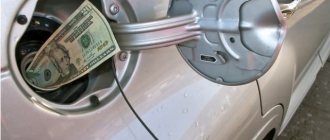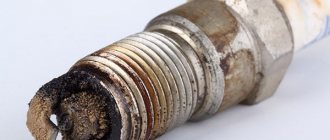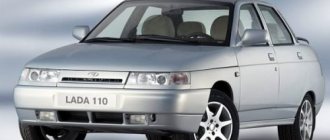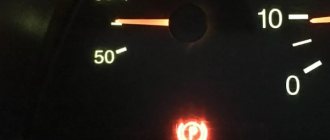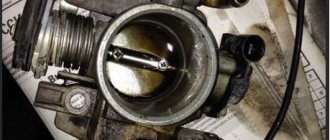VAZ 2110
Today, high gas consumption of the VAZ 2110 is a fairly common problem among car owners. High gasoline consumption for a VAZ 2110 can occur for various reasons. However, before you “treat” the car, it is worth finding what is causing the car to function poorly. Indeed, if a car begins to overuse fuel, then this is bad, as undesirable consequences may appear.
How to reduce fuel consumption on a VAZ 2110 injector 8 valves
There may be many reasons why fuel consumption has increased. Let's look at the most common ones. This phenomenon may indicate dishonesty at the gas station. At gas stations they try to deceive us: they don’t add gasoline, they sell low-quality fuel through the use of additives, sometimes they simply dilute it with water. The first thing you need to do is change the gas station.
If the consumption is still high, then it is necessary to take compression measurements in the cylinders. There is a direct relationship between engine power and compression: if one indicator decreases, then the other decreases as well. Accordingly, in order to achieve the same dynamics, it is necessary to press the trigger harder, which leads to high gasoline consumption. Compression can decrease for various reasons: leaky valve seals to the seats, loss of mobility of the piston rings, wear of the car engine components. The wear of the cylinder-piston system can be determined using a corrected air flow sensor. It is enough to compare its current reading with the standard for a specific electronic control unit. If the resulting value is less, this indicates wear and tear on the system. Moreover, the more the indicator differs from the standard, the higher the wear. When the piston rings become coked, the engine does not need to be disassembled. It is enough to use decoking agents. Next, you should evaluate the condition of the spark plugs. Black carbon deposits on them indicate an enriched fuel mixture. It does not burn completely, its remains fly out into the pipe, so high fuel consumption occurs on the VAZ 2110 injector, the reasons for which are related to filter clogging, improper operation of the mass air flow sensor and the air pressure sensor. The over-enrichment of the fuel mixture in an injection engine is influenced by the thermostat. If its valve opens earlier than necessary, the engine does not warm up to operating temperature. The electronic control unit will react in a timely manner - it will begin to supply a rich mixture. The reasons for the over-enrichment of fuel for a carburetor engine are associated with its incorrect adjustment or clogging of the filter. Light soot indicates that the fuel mixture is “poor”. When working on it, engine power decreases. In this case, gasoline consumption has increased due to: malfunctions or incorrect engine adjustments - for carburetors; low pressure in the fuel line, malfunctions of the mass air flow sensor and DTOZh - for injectors. Reduced pressure in the fuel line indicates a clogged fuel filter or wear of the fuel pump. Increased fuel consumption on a VAZ 2110 (8-valve injector) may be caused by other faults in the fuel system. For example: malfunction of the fuel return valve, clogged injectors (they do not atomize fuel well, so the fuel mixture is of poor quality). If fuel consumption increases during the cold season, then this is normal. The load on the engine increases. It takes more time to warm up the engine, which also cools down very quickly. Additional energy is required to heat the interior even in the realities of driving on ice and snow (slippage, etc.). The engine endures loads due to the viscosity of the oil in the gearbox and the grease in the bearings. Of course, gasoline consumption in winter is higher than in the warm season. This difference is insignificant, but sometimes it can take a shocking turn. For example: fuel consumption on a VAZ 2110 1.5 injector when used over long distances in winter can be increased by only a few liters. At the same time, consumption when driving short distances on a snowy road can increase by 2 times. High fuel consumption on the VAZ 2110 8-valve injector can be associated with driving style. So with constant acceleration and braking, the indicator increases. It is also influenced by: the quality of rubber, the absence of flat tires, an increase in the weight of the vehicle due to its improvement (tuning accessories, installation of large speakers). The load on the engine may be overestimated due to incorrect wheel angle setting. Timely identification of the cause of increased fuel consumption will save the budget and prevent deterioration in vehicle performance.
content .. 34 35 36 37 ..Lada VAZ-2110 (2111, 2112). Increased fuel consumption
| Check the condition of the air filter replacement element | Blow or replace the air filter element | |
| Leaking power system | Smell of gasoline, fuel leaks | Check the tightness of the connections of the fuel system elements; If a malfunction is detected, replace the corresponding components |
| Spark plugs are faulty: current leakage through cracks in the insulator or carbon deposits on the heat cone, poor contact of the central electrode | Spark plugs are checked on a special stand at a service station. The absence of external damage and sparking between the electrodes on the inverted spark plug does not allow us to draw a conclusion about its functionality | Replace spark plugs |
| Throttle actuator malfunction | Check the travel of the gas pedal, the clearance in the drive (free play of the pedal), make sure that the cable and pedal are not jammed | Replace faulty parts, lubricate the cable with engine oil |
| The idle speed controller or its circuits are faulty | Replace the regulator with a known good one. | Replace the faulty regulator |
| The throttle valve does not close completely | The gap between the throttle valve and the walls of the housing is visible in the light | Replace the throttle assembly |
| Increased pressure in the fuel line due to a faulty pressure regulator | Check the pressure in the fuel system with a pressure gauge (no more than 3.5 bar) | Replace the faulty regulator |
| Leaking injectors | Check the injectors | Replace faulty injectors |
| The coolant temperature sensor or its circuit is faulty | Check the sensor resistance with an ohmmeter at different temperatures | Restore contact in electrical circuits, replace the faulty sensor |
| The oxygen concentration sensor is faulty | You can evaluate the performance of the oxygen concentration sensor and the reliability of its electrical circuit connections using diagnostic equipment at a service station | Restore damaged electrical circuits, replace faulty sensor |
| The ECU or its circuits are faulty | To check, replace the ECU with a known good one. | Replace the faulty ECU, restore damaged electrical circuits |
| Low compression in the engine cylinders (less than 11.0 bar): clearances in the drive are not adjusted, wear or damage to the valves, their guides and seats, stuck or broken piston rings | Check compression | Adjust the clearances in the valve drive. Replace faulty parts |
| The throttle position sensor, absolute pressure and air temperature sensors in the intake manifold or their circuits are faulty | Check the sensors and their circuits | Restore contact in the electrical circuits, replace the faulty sensor(s) |
| Increased resistance to gas movement in the exhaust system | Inspect the exhaust system for dented or damaged pipes, check the condition of the catalytic converter | Replace damaged exhaust system components |
| Malfunctions of the chassis and brake system | Check the chassis and brake system | Adjust the wheel alignment angles, replace faulty chassis parts, and troubleshoot the brake system. |
Reasons for high fuel consumption
There are several common mistakes that inexperienced drivers make that lead to excessive fuel consumption. Remember that excess gasoline or diesel fuel will be consumed when:
The operation of the air conditioner or climate control system. The operation of these devices is related to the operation of the compressor. After all, to rotate the pump pulley, energy is required, which is taken from the rotating crankshaft. And it requires additional fuel. The operation of the heating system. This applies not only to the operation of the “stove”, but also to heated seats, windows and mirrors (in cars where these options are provided). The logic here is similar to the situation described above. Sharp acceleration. If you like to pull away quickly at traffic lights or other places, then be prepared for the fact that your car will consume more fuel than usual. This is due to the fact that any transient process (in this case, setting the machine in motion) is associated with increased energy consumption. And the sharper it is, the more energy is needed. Therefore, try to move off smoothly. This way you will not only save fuel, but also save tires, clutch and power unit components. Engine running at high speeds. Try not to over-gas. This will not only save fuel for your car, but will also have a positive effect on the overall performance of the engine. Using low-quality fuel. Try to refuel at trusted gas stations and fill the tank with the brand of fuel recommended by the car manufacturer. After all, bad fuel burns worse, provides insufficient energy and requires additional energy consumption.
Technical reasons for increased fuel consumption
First, let's look at the technical problems that contribute to increased gas mileage in a car. Let's find out the most common reasons related to the engine and other elements that increase consumption.
Engine wear
Usually occurs due to high mileage of the car or due to improper use. Some points related to engine operation:
- coolant (coolant) temperature is lower than calculated; - wear of the cylinder-piston group; - wear of the crank mechanism; - wear of the gas distribution mechanism and unadjusted valve clearances.
Clutch wear
When the driver needs to keep high revs in order to get off the road and switch to a higher gear, this directly affects fuel consumption. In this case, replacing the clutch will help.
One of the reasons for increased fuel consumption is clutch disc wear. The situation here is quite simple. During the starting process, the engine consumes more fuel than at constant speed. This fact is present even with a working clutch. If the disk or other parts of the system are faulty, then it turns out that fuel is consumed, and the car stands still. The more often the car starts moving, the greater the excess fuel consumption occurs.
In critical cases, a similar situation can occur even when driving in constant mode. That is, when the clutch disc does not ensure synchronous rotation of the engine and gearbox. This situation, although rare, can happen in the most “neglected” cases.
Diagnosing clutch wear is quite simple. To do this, you need to put the car on the handbrake, engage fifth or fourth gear (depending on the gearbox, that is, the highest) and try to get going. If you do not turn off the engine with gas, this means that the clutch needs to be repaired or completely replaced.
Ignition set incorrectly
Incorrectly set ignition also causes increased fuel consumption. In particular, if the engine “troubles”, then gasoline from the idle cylinder is released directly into the exhaust system. This leads not only to excessive fuel consumption, but also to increased wear of the catalyst.
If the ignition is simply set incorrectly, then a situation arises when the fuel does not burn completely. That is, a spark occurs before the fuel mixture appears in the cylinder in full, or after that. In any case, this leads to its incomplete combustion. This automatically means that fuel is wasted.
Therefore, always monitor the condition of the ignition system. The amount of fuel consumed directly depends on this. In addition, an incorrectly configured ignition system can cause problems when starting the engine.
Tire wear
If the tires are worn out enough or the pressure in them is less than normal, this will also lead to the car starting to “eat” more than it should. In such a situation, it is necessary to replace the tires and regularly check the tire pressure. Low-profile tires with a wide tread create increased resistance and, accordingly, increased fuel consumption.
Malfunctions of the brake system They are different, let’s consider those that lead to incomplete release of the calipers, when the so-called “wedging” occurs. If the caliper is not fully unclenched, then over time not only the brake pads, but also the discs become unusable. Due to excessive friction and resistance, fuel consumption naturally increases.
Broken spark plugs
Due to unsuitable spark plugs, the car does not operate correctly, which results in additional load on the engine. This leads not only to high fuel consumption, but also to a general deterioration in performance. To avoid this, you need to check the spark plugs. Such a check includes examining the color of carbon deposits, measuring the electrode gap, and checking the resistor for breakdown. It is also worth paying attention to the junction of the white insulator to the threaded part of the spark plug - a red coating is unacceptable.
Clogged injectors or carburetor
Clogged injectors are one of the most common causes of excessive fuel consumption. They become clogged due to natural causes. These include the use of low-quality gasoline, untimely replacement of the fuel filter, dirt getting into the engine compartment, and so on.
When the injectors are clogged, the shape of the fuel spray pattern in the combustion chamber is disrupted. Because of this, the formation of the fuel mixture is disrupted. That is, this process uses more gasoline than is necessary under normal conditions.
In some cases, due to clogged injectors, the engine may begin to “trouble.” This is expressed in a decrease in the dynamic characteristics of the car. It is also possible for the engine to operate for a long time at high speeds, even in idle mode. This naturally leads to increased fuel consumption.
Similar reasoning is valid for cars with a carburetor engine. When the carburetor becomes clogged, the same situation arises with excessive consumption of gasoline and a drop in dynamic characteristics.
Therefore, always monitor the condition of the fuel system, in particular, the injectors on an injection engine and the carburetor on a carburetor. Their clogging is a direct cause of excessive fuel consumption.
Low-octane fuel also has a great effect on consumption (low price and poor quality come with quantity).
Damage to the lambda probe or mass air flow sensor
Failure of the oxygen sensor (lambda probe) can also lead to significant excess fuel consumption. Its task is to control the amount of oxygen that goes into the fuel mixture. Therefore, if this sensor is faulty, the mixture will be created incorrectly, and this will lead to excessive fuel consumption.
The lambda probe is quite fragile. There are a number of reasons why it can fail. Among them:
-depressurization of its body and penetration of exhaust gases into it; - overheating of the sensor (this may be caused by incorrect operation of the ignition system); -natural aging and wear; - problems with the car's electrical network; - mechanical damage to the sensor. Similar reasoning applies to the mass air flow sensor (MAF). It is designed to regulate the level of air supply to the engine cylinders. Sensor malfunctions are easy to identify. As a rule, in this case the engine begins to operate unstably, especially at idle (very high or low “jumping” speeds), loss of dynamic characteristics (the car accelerates poorly). The mass air flow sensor cannot be repaired. It can only be replaced, although cleaning it may temporarily correct the situation.
Clogged air filter
The recommended replacement frequency is every 15,000 km. Timely replacement of the air filter is required, because if it is clogged and you ignore it, then be prepared for the car to have a good appetite.
Consumption is also affected by the use of air filter elements with heavy fabric pre-cleaners, since, as in the case of a clogged filter, air resistance increases. Lightweight filter elements are recommended to minimize air flow resistance.
content .. 34 35 36 37 ..
Re: high fuel consumption, no errors
No, I’m not arguing that the fault can be determined by looking at the spark plug insulators at 60. I did the same thing myself, but I only took a whole range of measures to find the fault. The reasons are an increase in engine warm-up time, the load on the engine has increased due to an increase in the viscosity of the oil in the engine and gearbox, the same thing happens with the grease in the bearings of hubs and grenades, rapid cooling of the engine, the interior heater is constantly running, frequent wheel slipping in snow and ice.
Setting up injectors on professional equipment
Everything depends on the serviceability of the fuel injector in injection systems. The engine will operate properly and without problems only if the injectors are in good working order and accurately adjusted. Even a minimal inversion of the performance of one of the injectors will affect the capabilities of the engine and its dynamics. And periodic operation of a machine with such nozzles will ultimately lead to expensive repairs of the internal combustion engine.
To adjust the injectors you will need bench equipment. Special tools are also needed. Due to the lack of such equipment in the garage, it is customary to entrust the work of setting up injectors to specialists in a car service center.
Here's how the adjustment is made.
- The technician at the stand checks the nozzles, determines the tightness, and the degree of pressure at the moment the nozzle needle moves. If it notices discrepancies with standard parameters, it begins the adjustment process.
- The required pressure is set by rotating the screw with a lock nut, which is responsible for raising the locking needle. This type of adjustment is called smooth adjustment. But stepwise pressure adjustment involves the use of washers with different thicknesses.
- The degree and angle of fuel spray is adjustable. If the quality of the atomized fuel cannot be normalized, the atomizer is replaced.
How to determine a faulty oxygen sensor Throttle sensor
| Gasoline consumption VAZ 2110 engine 8 valve If the fluid coupling is not blocked, the engine constantly works with increased load, so high gasoline consumption in a VAZ or other car is guaranteed. Consumption is also affected by the use of air filter elements with heavy fabric pre-cleaners, since, as in the case of a clogged filter, air resistance increases. |
- Reason 3 - fuel system pressure. In this case, an increase in pressure is quite rare, while a decrease is very common. In the end, the engine power (see How to properly repair an engine) decreases, so it runs longer to ensure normal operation of the car. As a result, the VAZ 2110 consumes high gasoline.
How to reduce costs • 2 high fuel consumption in this case is ensured.
conclusions
- Check actual costs with the on-board computer readings. Make a full refuel, record the mileage data.
- Regular diagnostics of malfunctions will promptly identify the cause of the defect that affects increased gasoline consumption.
- Don’t delay, don’t save, because the consequences will definitely lead to serious, expensive repairs.
–> VAZ Masters / Engine power system / Fuel consumption
VAZ 2110
How to determine if fuel consumption is increased
As a rule, each automaker in its documentation defines the so-called “passport” gasoline consumption (fuel consumption standards) for a particular car model with a specific type of engine and gearbox. It should be understood that this consumption according to the passport was obtained under ideal conditions (high quality fuel, complete serviceability of components, systems and assemblies), minimal loads, etc.
In reality, consumption usually differs from the passport value by at least 15-20% upward. Moreover, you need to take into account the individual operating conditions of the car. It is not difficult to guess that driving on the highway at a constant speed will require much less fuel than constant acceleration and stopping in the city.
In turn, the following can be considered an increase in fuel consumption:
Varieties
This car model has gone through several modifications and this has affected the internal engine systems, some external design details and fuel consumption figures.
1.5i (79 hp petrol) 5-mech
1.6 (80 hp petrol) 5-mech
1.6i (89 hp, 131 Nm, petrol) 5-mech
1.5i (92 hp, petrol) 5-mech
| Engine | Consumption (highway) | Consumption (city) | Consumption (mixed cycle) |
| 1.5 (72 l. petrol) 5-mech | 5.5 l/100 km | 9.1 l/100 km | 7.6 l/100 km |
| 5.3 l/100 km | 8.6 l/100 km | 7.2 l/100 km | |
| 6 l/100 km | 10 l/100 km | 7.5 l/100 km | |
| 6.3 l/100 km | 10.1 l/100 km | 7.7 l/100 km | |
| 7.1 l/100 km | 9.5 l/100 km | 8.1 l/100 km |
There are different types of VAZs:
:
- 8-valve with 1.5 l engine (carburetor);
- 8-valve injector with 1.5 engine;
- 16-valve 1.5 engine injector;
- 8-valve 1.6 l engine injector;
- 16-valve engine with a volume of 1.6 liters and injector.
Each version of the VAZ has its own advantages and disadvantages, especially regarding fuel consumption. But after the release of cars with a different fuel supply system, the weaknesses of the first VAZ model became clearly visible. One of them is the fuel consumption of the 2110 injector, which has decreased significantly due to this modification of the fuel system.
It is usually quite difficult for the average driver to explain the intricacies of the calculation being carried out.
If you like to pull away quickly at traffic lights or other places, then be prepared for the fact that your car will consume more fuel than usual. If high gasoline consumption is due to slight wear or coking of the piston rings, the situation will be improved by using a special additive in Suprotek Active Plus or Suprotek Active Standard engine oil.
Engines with different numbers of valves
Let's start with the fact that the consumption rate will be different for different types of engines, which differ in the number of valves and design features. The first tenth Lada was equipped with a 1.5 carburetor engine producing 72 hp. This modification was produced for a relatively short time, only 3 years (1996–1999).
Next, it’s time for injection engines. First, let's look at the 8-valve power unit. This engine could not boast of special dynamics and power of 76 hp. for volume 1.5 and 81 hp. for later 1.6. But fuel consumption in the city was slightly higher than 9 liters, and outside it dropped to 5.5 liters per 100 km.
The 16-valve engine was structurally new for the giant plant and, in a sense, revolutionary. Its volume could be 1.5 or 1.6 liters, with the former being more powerful. The average gasoline consumption in both cases is approximately the same - 7.2 - 7.3 liters (at least, this is what the manufacturer declares). At the same time, in the city it takes up to 9 liters, and on the highway some 5.5 liters.
| Engine, modification | Fuel consumption in the urban cycle, l/100km | Fuel consumption in the extra-urban cycle, l/100km | Fuel consumption in the combined cycle, l/100km |
| 2110 1.5 (72 hp) 8 valves, carburetor | 9,1 | 5,5 | 7,6 |
| 21101 1.6 (81 hp) 8 valves, injector | 7,5 | 5,3 | 7,2 |
| 21102 1.5 (78 hp) 8 valves, injector | 8,6 | 5,3 | 7,2 |
| 21103 1.5 (94 hp) 16 valves, injector | 8,8 | 5,5 | 7,2 |
| 21104 1.6 (89 hp) 16 valves, injector | 7,7 | 5,5 | 7,2 |
| 21106 engine OPEL 2.0 (148 hp) 16 valves, injector | 9,8 | 5,4 | 7,1 |
The fuel consumption of the VAZ 2112 hatchback will be almost the same, and the VAZ 2111 station wagon with the same power units is 0.1–0.3 liters per 100 km higher.
Air regulator
The ECM is the electronic engine control system. And she needs to know how much air to supply for the amount of fuel supplied. These two parameters are closely interrelated because they allow you to create an optimal air-fuel mixture.
Having determined the amount of air, the system determines the required volume of gasoline. The air sensor is responsible for the suction volumes. The disadvantages of this device include:
- Due to exposure to moisture, performance is impaired;
- At low speeds, the sensor produces increased readings;
- The device cannot operate normally when idling;
- Problems may arise when starting the engine;
- After increased power mode, the engine may stop abruptly;
- Fuel consumption increases.
How does this sensor work? Let's try to figure it out.
- The regulator design includes three sensitive components that are installed in the air flow. One of the elements determines the temperature of the intake air, and the other two heat up to the required levels.
- Air flow is determined by measuring the power of electricity to maintain the required temperature.
- The regulator has a mesh that is mounted in the air flow.
- All this allows you to transfer information to controllers, which, in turn, enable certain modes to change or maintain loads.
Article on the topic: Technical features of the VAZ 2114
Idle speed control
Today, in urban environments, drivers simply cannot do without idling. Therefore, every car, including the VAZ 2110, is equipped with an idle speed sensor. Incorrect operation or failure of this regulator will significantly complicate driving, because it will cause the engine to stop even during the shortest stops. So if the controller fails, and this is not uncommon in VAZ 2110 cars, it needs to be changed as quickly as possible.
Removing the idle air control
The main purpose of this type of regulator is to support the speed required for normal operation of the power unit. Thanks to the device, the driver can always make a short stop as a result of changing the incoming air volume. As for the location, this controller is installed on the throttle line. In particular, we are talking about an anchor stepper motor, which is equipped with two windings.
When a corresponding signal is received on one of the windings, a special needle moves forward one step and backwards one step. Thanks to the worm gear, the device rotates, which is produced using a stepper motor, thus converting this movement into translational. The rod itself, namely its conical part, is located in the line through which the air flow is supplied.
Thanks to the functioning of the rod, the system adjusts the idle speed of the power unit. The rod from the device, as mentioned above, can be retracted or extended. In this case, it all depends on what kind of pulse will be supplied from the regulator. The controller itself allows you to adjust the frequency at which the engine crankshaft will rotate when the machine is stopped for a short time.
In addition, the controller controls the incoming air flow, which bypasses the throttle in the closed position. When the engine is warmed up, the regulator, by controlling the movement of the rod itself, at idle speed allows you to maintain the required crankshaft speed. In this case, the load and condition of the power unit do not play a role.
Replacement process
Replacing the coolant temperature sensor VAZ 2110
To check and replace the temperature device, you will need the following tools and materials:
- Socket wrench set to “19”;
- Sealant;
- Coolant;
- Copper washer.
Note. The temperature sensor is located in the VAZ 2110, often in the intake manifold near the thermostat housing, rarely in the cylinder head. It is installed so that the tip comes into contact with the coolant. Only in such cases is his signal correct. If the coolant level is low, the sensor readings may be incorrect.
Crankshaft regulator
New crankshaft controller for the “ten” Depending on the type of car, on a 16- and 8-valve engine, the location of all controllers may be different.
However, all of these devices combine into one functioning system, and the crankshaft adjuster is no exception. Thanks to this controller, the electronic engine management system of the “tens” can independently determine at what point to supply gasoline and a spark through the spark plugs in order to ignite the combustible mixture. In fact, the design of the device is a magnet, as well as a coil of thin wire. The crankshaft sensor has certain advantages:
- As practice shows, at “tens” this regulator can work for quite a long time. Its service life does not decrease even as a result of using the vehicle’s power unit under increased loads.
- The crankshaft adjuster works in conjunction with the crankshaft pulley.
- If the device fails, the engine may not be able to start. Or, if the regulator breaks down, the speed parameters will be reduced to 3.5 thousand per minute.
This controller is installed on the oil pump, actually at the very top of the shaft teeth. Or rather, one millimeter from the cloves. You can learn more about how to replace this controller yourself from the video below (the author of the video is the channel In Sandro’s Garage).
Influence of time of year, temperature and sensor serviceability
Again, a lot depends on the time of year. In winter, every vehicle uses much more fuel. This is due to the long warm-up of the engine, the condition of the road surface, and periodic slipping. In the summer months, the basic consumption rate decreases if you do not keep the windows open when driving at high speeds.
Another reason has to do with the functioning of the sensors. If they are set incorrectly, they will not be able to correctly calculate the sufficient volume of the air-fuel mixture, as required by the engine control unit. This is an oxygen sensor, an air metering sensor and others. As a result, an overly enriched mixture begins to form, which empties the tank in a short time.
The first cars in this series have a carburetor engine, which can be manually adjusted to reduce fuel consumption. It will not be possible to set up an injection engine in the same way. However, it is periodically necessary to look into the injectors of the power unit and check whether they are clogged. If clogged, they begin to spray more gasoline, while the quality of the working mixture remains low.
It is known that the normal temperature of the power unit should be in the range of 90–100 degrees Celsius. As soon as it starts to overheat, the mixture becomes unnecessarily discharged. Engine power immediately drops, which leads to excessive fuel consumption. There is also the concept of “instant fuel consumption,” which is reflected on the trip computer screen. But unfortunately, not all cars are equipped with it. This indicator is influenced by the speed of movement and engine speed. In some cases, it can amount to tens of liters per hundred kilometers, but you should not be afraid of this, since we are talking only about the every second value when accelerating the car in low gears.
With this we will say goodbye. Subscribe to blog updates to continue receiving interesting newsletters. See you again, dear car enthusiasts!
Messages 19
1 Topic by chev-viktor 2014-05-12 23:27:31
- chev-victor
- New member
- Inactive
- From: Rostov-on-Don
- Registration: 2014-02-17
- Messages: 96 Thanks : 7
- Car: VAZ2112
Topic: high fuel consumption, no errors
Here's the same problem: driving around the city, consumption is 12-13 liters, calm style without traffic jams. Outside the city, consumption is 7-8. that I didn’t do anything on the forum, they didn’t really suggest anything, but now I’m going to change the injectors and DPZ and I want to install a BC. Maybe then we'll be able to track something down?
On diagnostics everything works exactly like this.
2 Reply from Serg 2014-05-13 07:46:08
- Serg
- Lada2111.rf fan
- Inactive
- Registration: 2013-07-29
- Messages: 830 Thanks : 363
- Car: 2111 dwg 2114 year 2008
Re: high fuel consumption, no errors
In my opinion, Krasnodar is not far from you, contact Sergey Fedorenko, you can find him here - club.motor-master.ru/viewtopic.p … amp;t=3958
3 Reply from klimashov.roman 2014-05-13 07:58:33
- klimashov.roman
- Connoisseur
- Inactive
- From: Kasimov
- Registration: 2014-04-21
- Messages: 743 Thanks : 143
- Car: GAZelle 33023 dv 405.22, 2.4 16kl 140hp
Re: high fuel consumption, no errors
why change the injectors? If they are normal, it’s just a waste of money, you can simply wash them. So, check all the sensors by poking a tester of some kind and it dies, since not all of them give an error. As for the TPD, not all of them take root, so BC will be very useful for you.
4 Reply from igorek 2014-05-13 08:32:02
- igorek
- Brother-in-law
- Inactive
- From: Bryansk region g Starodub
- Registration: 2013-05-05
- Messages: 416 Thanks : 191
- Car: VAZ-21102 1.5i-8V Bosch MP7.0H
Re: high fuel consumption, no errors
chev-viktor , high fuel consumption? What condition are the spark plugs in? and it is the insulator that you can judge by the insulator the condition of the engine, which mixture is enriched or leaner, from this you need to draw conclusions and look for the reason, I found out when I had a very lean mixture, unaccounted air entered the combustion chamber of errors, while there were not one, all sensors were working spark plugs They helped me and gave me some advice, although many convinced me that it wouldn’t work, don’t interfere and don’t interfere with the car’s work, drive, they say, all this is refutable, miracles don’t happen
5 Reply from klimashov.roman 2014-05-13 11:28:13
- klimashov.roman
- Connoisseur
- Inactive
- From: Kasimov
- Registration: 2014-04-21
- Messages: 743 Thanks : 143
- Car: GAZelle 33023 dv 405.22, 2.4 16kl 140hp
Re: high fuel consumption, no errors
Well, if there is unaccounted air, the car will adjust a little at XX. But air leaks are one of the first reasons.
6 Reply from igorek 2014-05-13 12:42:31 (2014-05-13 13:31:06 edited by igorek)
- igorek
- Brother-in-law
- Inactive
- From: Bryansk region g Starodub
- Registration: 2013-05-05
- Messages: 416 Thanks : 191
- Car: VAZ-21102 1.5i-8V Bosch MP7.0H
Re: high fuel consumption, no errors
klimashov.roman , there was nothing wrong with me, everyone was amazed and the engine was running smoothly thanks to good compression and an adjusted cylinder head, and the mixture was poor. The spark plug insulator after a run of 10,000 was white, like a brand new spark plug. The only thing that was bad in hot weather was that the heated engine became the question became sluggish and pensive, and one experienced master suggested this to me at one time, and in order to troubleshoot the spark plug insulator, you can determine which mixture is supplied to the engine, rich or poor, and draw conclusions from this
Technical specifications
By choosing the VAZ-2110, future owners will have at their disposal a car with improved performance of all systems, without exception, if we compare the “ten” with previous VAZ analogues.
Among the basic technical data, which are not only improved, but also responsible for gasoline consumption, are the following:
- engine capacity 1.5 horsepower;
- carburetor or injector;
- front-wheel drive;
- mechanical type gearbox.
In just 14 seconds, the VAZ-2110 can accelerate to a maximum speed of 165 km/h.
Average gasoline consumption per 100 km
The sensor indicates how much gasoline the car consumes, and this indicator varies depending on the engine type:
- with a 1.5, 72 liter engine. With. consumption in the city is 9 liters, and on the highway – 5.5 liters;
- a car equipped with a 1.6, 89 liter engine. pp., consumes 10 liters in the city, and 6.3 liters on the highway;
- owning a VAZ-2110 with a 1.5, 92 liter engine. pp., motorists should know that a car will consume 9.5 liters per 100 km within the city, and 7.1 liters on the highway.
The optimal fuel consumption per 100 km is considered to be 6.5 liters for any brand of car, if we consider this point from an economic point of view. The average consumption of the VAZ-2110 ranges from 5.5 to 10 liters per 100 km. That is, this indicator is quite acceptable for one of the most popular models of a domestic manufacturer.
